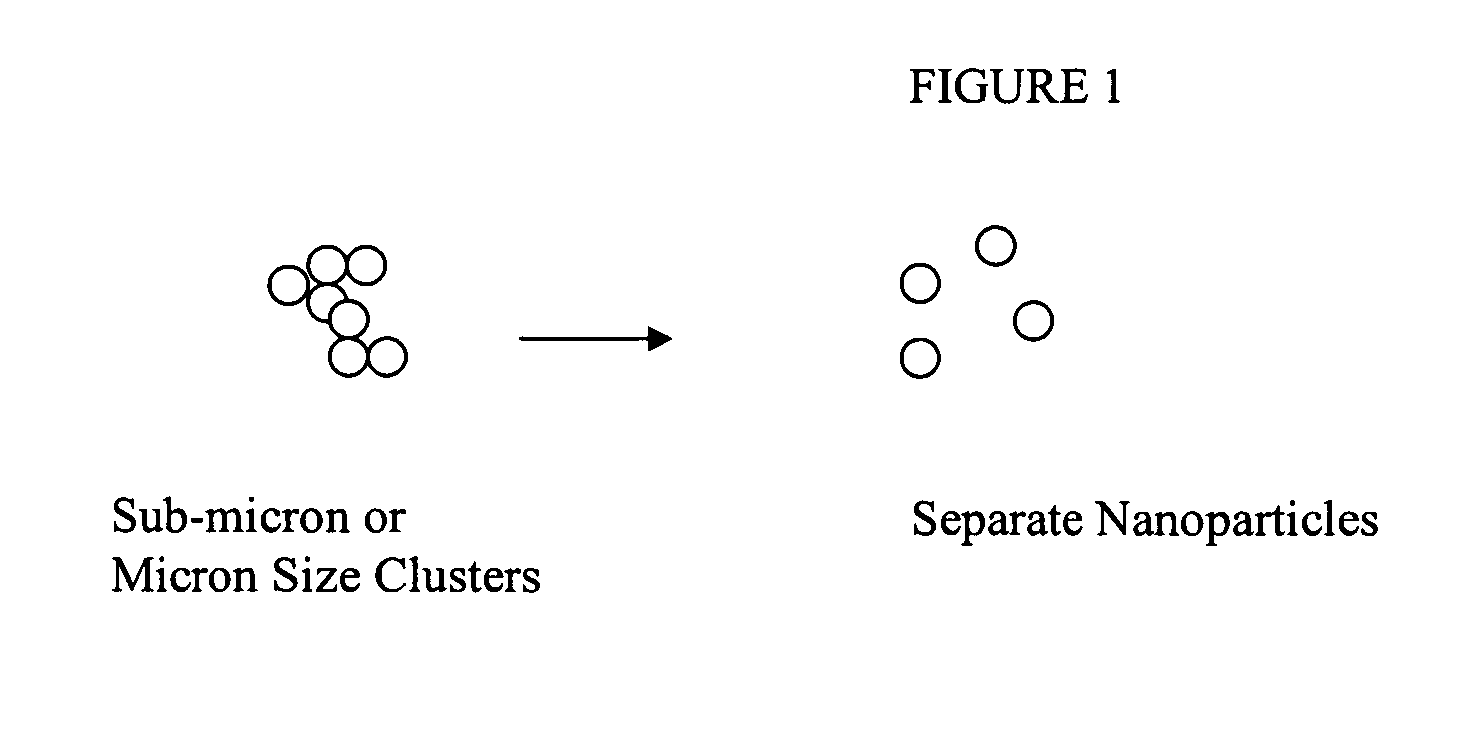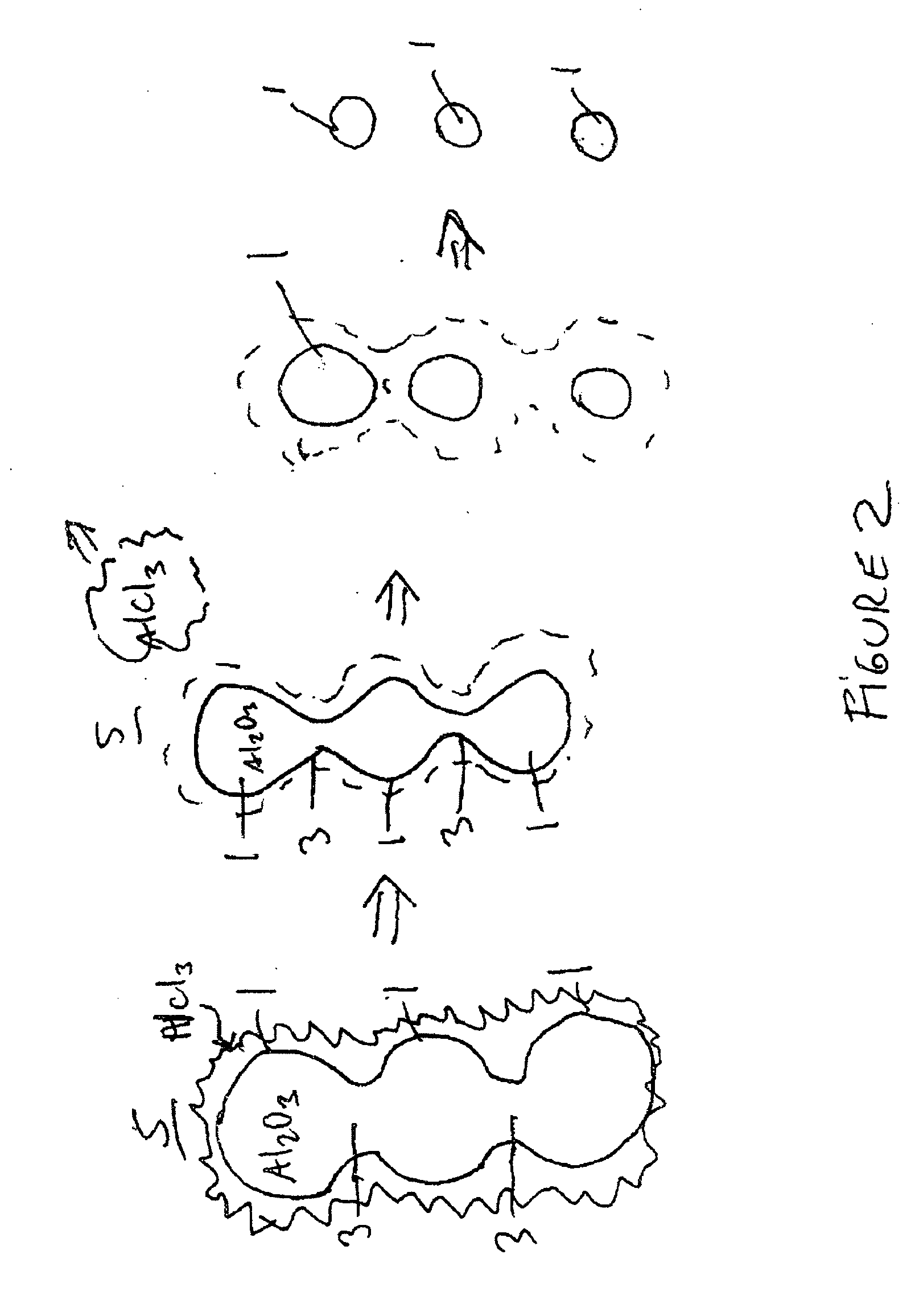Nanoparticles and method of making thereof
a technology of nanoparticles and nanoparticles, which is applied in the preparation of silicon oxides, alkaline-earth metal aluminates/aluminium-oxide/aluminium-hydroxides, etc., can solve the problems of nanoparticle contamination, unsuitable for large-scale production, and inability to grind uniformly
- Summary
- Abstract
- Description
- Claims
- Application Information
AI Technical Summary
Benefits of technology
Problems solved by technology
Method used
Image
Examples
first embodiment
[0020] In the invention, the etching material is provided in the solid state. The etching material may be mixed with the powder. The mixture is then heated to a temperature at which the etching material is dissolved into the liquid state while the powder material remains in the solid state. The liquid etching material then etches the powder and dissolves the nanoparticle clusters, such as submicron hard clusters, to provide the desired nanoparticle size distribution.
second embodiment
[0021] In the invention, the etching material is provided in the liquid state. The powder is provided into the liquid etching material or into a solution into which the liquid etching material is provided before and / or after the powder. The liquid containing the etching material and the powder is heated to a temperature below which the powder is converted to the liquid phase. The liquid etching material then etches the powder and dissolves the nanoparticle clusters to provide the desired nanoparticle size distribution.
[0022] Preferably, in the processes of the first and the second embodiments, the heating facilitates a chemical reaction between the etching material and the powder. Preferably, the heating causes a chemical reaction between the metal or semiconductor element (such as elements from Groups IA-IVA and IB-VIIIB of the Periodic Table of Elements) of the powder compound and a portion of the etching material compound, such as a Group VIIA element (such as Cl, F or Br) or ace...
third embodiment
[0043] In the invention, the by-products of the etching and chemical reaction are recycled to form additional nanoparticles to increase the yield of the nanoparticle formation process. For example, the following reaction produces a metal chloride by-product: ZnO (powder)+HCl+H2O=ZnO (nanoparticles of smaller size than the powder)+ZnCl2+H2O.
[0044] The following three exemplary processes will be described with respect to zinc oxide. However, other nanoparticles, such as alumina, ceria, zirconia, zinc oxide, silica and titania (i.e., having a formula AB, where A comprises at least one element from Groups IA-IVA and IB-VIIIB, and B comprises at least one element from group VIIA) may be formed using this process. In these cases, the metal or semiconductor chloride or other by-product is recycled. It should be noted that the recycling method of the third embodiment may be used with elevated temperature etching methods of the first or the second embodiments or with room temperature etching...
PUM
 Login to View More
Login to View More Abstract
Description
Claims
Application Information
 Login to View More
Login to View More - R&D
- Intellectual Property
- Life Sciences
- Materials
- Tech Scout
- Unparalleled Data Quality
- Higher Quality Content
- 60% Fewer Hallucinations
Browse by: Latest US Patents, China's latest patents, Technical Efficacy Thesaurus, Application Domain, Technology Topic, Popular Technical Reports.
© 2025 PatSnap. All rights reserved.Legal|Privacy policy|Modern Slavery Act Transparency Statement|Sitemap|About US| Contact US: help@patsnap.com



